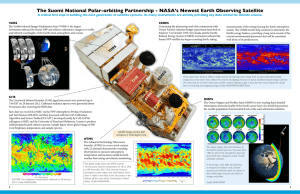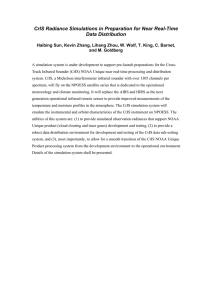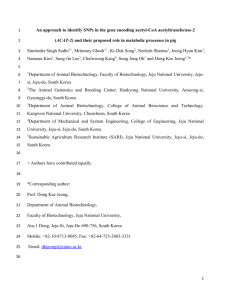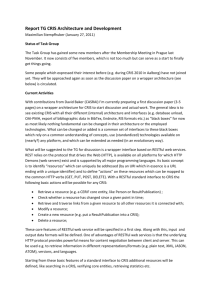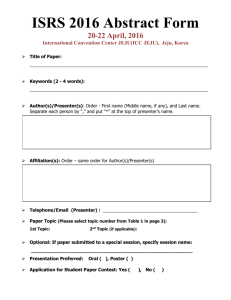Explicit Retrieval of Cloud and Atmospheric X. Liu
advertisement
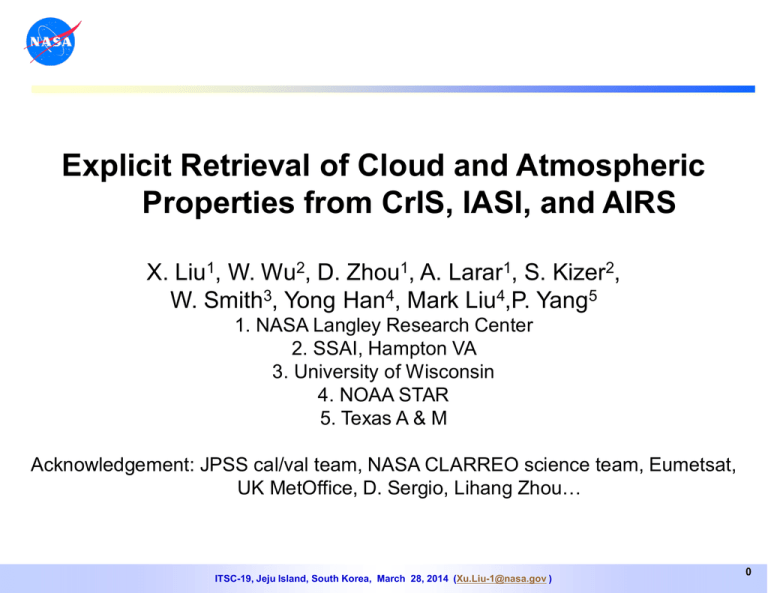
Explicit Retrieval of Cloud and Atmospheric Properties from CrIS, IASI, and AIRS X. Liu1, W. Wu2, D. Zhou1, A. Larar1, S. Kizer2, W. Smith3, Yong Han4, Mark Liu4,P. Yang5 1. NASA Langley Research Center 2. SSAI, Hampton VA 3. University of Wisconsin 4. NOAA STAR 5. Texas A & M Acknowledgement: JPSS cal/val team, NASA CLARREO science team, Eumetsat, UK MetOffice, D. Sergio, Lihang Zhou… ITSC-19, Jeju Island, South Korea, March 28, 2014 (Xu.Liu-1@nasa.gov ) 0 Presentation outline • Motivations • Principal Component-based Radiative Transfer Model (PCRTM) • PCRTM retrieval algorithm (PCRTM-RA) and applications • Summary and Conclusions ITSC-19, Jeju Island, South Korea, March 28, 2014 (Xu.Liu-1@nasa.gov ) 1 Motivations • Need fast radiative transfer model to handle hyperspectral data – Modern sensors have thousands of channels and 0.1-1 million spectra per day – Only 4-10% of spectral channels are used in satellite data assimilations – Examples hyperspectral sensors: • AIRS 2378 x 1 x1 • • • • • • CrIS NAST-I IASI FIRST CLARREO 1305 x 3 x 3 8632 x 1 x 1 8461 x 2 x 2 ~1500x10 (or more) thousands Need a forward model that can treat cloud radiative transfer accurately and efficiently – Most of the sounder footprints contain cloud signatures – Cloudy radiance data assimilation is a big challenge – Current Cloud Clearing algorithm has limitations • Need to make assumptions about the inhomogeneity of the scene • Hard to characterize the error of the cloud cleared radiances and products • PCRTM (Principal Component-based Radiative Transfer model) was developed to satisfy the need listed above – – – – – Initially developed in 2004 Extends from 50 cm-1 (200 µm) to 33333 cm-1 (300 nm) Milliseconds per spectrum in IR 2-3 orders of magnitude faster than MODTRAN in solar spectral region 10% extra computation to include multiple scattering clouds ITSC-19, Jeju Island, South Korea, March 28, 2014 (Xu.Liu-1@nasa.gov ) 2 Introduction to PCRTM Forward Model • Explore spectral correlation in hyperspectral data – No need to calculate spectrum one channel at a time – Compress spectra into compact form using PCA, wavelet, Fourier Series etc – Reduce dimension of the data • PCA is a good approach for compressing spectra and capture information – Leading EOFs captures all essential information of thousands of channels – PCA has been used to reduce instrument noise and to compress spectra • PCRTM parameterization is physical-based fast model – – – – – – Radiative transfer done monochromatically at very few frequencies Very accurate relative to line-by-line (LBL) RT model ( < 0.05K or 0.05%) 3-4 orders of magnitude faster than LBL RT models A factor of 2-100 times faster than channel-based RT models Provides Jacobian or radiative kernel needed for retrievals and climate studies Includes accurate cloud RT ITSC-19, Jeju Island, South Korea, March 28, 2014 (Xu.Liu-1@nasa.gov ) 3 PCRTM is Physical and Fast • Example of O2 A-band • 12000 monochromatic RT LBL calculations needed to covr 759-771 nm spectral region • PCRTM reduces monochromatic RT calculation to 7 • • 1700 times faster than LBL Been trained for OCO (~0.04 nm) and SCIAMACHY (~0.2 nm) spectral resolutions ITSC-19, Jeju Island, South Korea, March 28, 2014 (Xu.Liu-1@nasa.gov ) 4 Computational Speed up in Solar Spectral Region • PCRTM reduces MODTRAN RT calculation by a factor or 28-928 depending on spectral resolution and MODTRAN accuracy chosen - PCRTM can handle ice and water clouds Aerosols Various trace gases Land and ocean surfaces Multiple scattering calculation uses 4-32 streams • It takes 1 day to simulate 1 years of all sky SCIAMACHY spectra using PCRTM with 30 CPUs • It will take more than 2 years for the MODTRAN to do the same 0.3 µm-2.0 µm PCRTM RT MODTRAN RT speed up Ocean 1cm-1 956 259029 270 Land 1cm-1 1339 259029 193 Ocean 4nm 279 259029 928 Land 4nm 354 259029 731 ITSC-19, Jeju Island, South Korea, March 28, 2014 (Xu.Liu-1@nasa.gov ) 5 Computational Speed in IR Spectral Region • • • • • • Sensor Channel Number PC score (seconds) PC score + radiance PC score + PC Jacobian CLARREO, 0.1 cm-1 19901 0.014 s 0.022 s 0.052 s CLARREO, 0.5 cm-1 5421 0.011 s 0.013 s 0.039 s CLARREO, 1.0 cm-1 2711 0.0096 s 0.012 s 0.036 s IASI, 0.25 cm-1 8461 0.011 s 0.012 s 0.044 s AIRS, 0.5-2.5 cm-1 2378 0.0060 s 0.0074 s 0.031 s CrIS,0.625-2.5 cm-1 1317 0.0050 s 0.0060 s 0.021 s NAST-I, 0.25 cm-1 8632 0.010 s 0.013 s 0.045 s S-HIS, 0.5 cm-1 4316 0.008 s 0.008 s 0.038 s CrIS, 0.625 cm-1 2211 0.009 s 0.009 s 0.033 s CrIS, CrIS-full-res, IASI, NAST-I and S-HIS have multiple databases corresponding to different apodization functions including unapodized spectra Spectral coverage (50-3000 cm-1) Multilayer, multiple scattering clouds included 15 variable trace gases It provide radiative kernel/Jacobian with minimum additional computations Non-LTE included ITSC-19, Jeju Island, South Korea, March 28, 2014 (Xu.Liu-1@nasa.gov ) 6 Accuracy of PCRTM is very good relative to reference RT models • Bias error relative to LBL is typically less than 0.002 K • The PDF of errors at different frequencies are Gaussian distribution • RMS error < 0.03K for IR and < 5x10-4 mW/cm2/sr/cm-1 for solar (< ~0.02%) ITSC-19, Jeju Island, South Korea, March 28, 2014 (Xu.Liu-1@nasa.gov ) 7 PCRTM has been validated using CrIS, IASI, AIRS, NAST-I, and SCIAMACHY real data ITSC-19, Jeju Island, South Korea, March 28, 2014 (Xu.Liu-1@nasa.gov ) 8 A brief description of the Optimal Estimation PCRTM Retrieval Algorithm (PCRTM-RA) PCRTM models PC scores directly − – – – – Small matrix and vector dimensions 100 super channels instead of thousands of channels Simply minimizing cost function Channel-to-channel correlated noise handled A Climatology covariance and background used as OE constraint – Climatology background used as first guess All parameters retrieved simultaneously – No need to estimate errors of non-retrieved parameters – Temperature – Water – Trace gases (CO2, CO, CH4, O3, N2O) – Surface temperature and emissivities – Cloud optical depth/size/phase/height/temperature – Product error covariance and averaging kernel provided for each retrieval at not extra computational cost MW retrieval capability added – CRTM used as forward model – PCRTM-RA can operate in 3 Modes – MW-only, IR-only, MW+IR ITSC-19, Jeju Island, South Korea, March 28, 2014 (Xu.Liu-1@nasa.gov ) 9 Example of Appying PCRTM-RA to CrIS/ATMS data Comparison of PCRTM-RA Retrieved and ECMWF Atmospheric Water Vapor from 515-2012 focus day CrIS/ATMS data 90% convergence rate. Retrieved 300 hPa from CrIS/ATMS using PCRTM-RA 300 hPa from ECMWF ITSC-19, Jeju Island, South Korea, March 28, 2014 (Xu.Liu-1@nasa.gov ) Comparison of PCRTM-RA Retrieved and ECMWF Atmospheric Temperature from 5-15-2012 focus day CrIS/ATMS data 500 hPa Retrieved from ATMS/CrIS using PCRTM_RA 500 hPa Temperature from ECMWF ITSC-19, Jeju Island, South Korea, March 28, 2014 (Xu.Liu-1@nasa.gov ) 11 Comparison of PCRTM Temperature Retrieval with IDPS Operational CrIMSS EDR Algorithm PCRTM CrIMSS ITSC-19, Jeju Island, South Korea, March 28, 2014 (Xu.Liu-1@nasa.gov ) Comparison of PCRTM retrieval with radiosondes • • • • Temperature, moisture, and ozone cross-sections Plots are deviation from the mean Fine water vapor structures captured by the retrieval system A very cloudy sky condition ITSC-19, Jeju Island, South Korea, March 28, 2014 (Xu.Liu-1@nasa.gov ) 13 Example of retrieved cloud properties ITSC-19, Jeju Island, South Korea, March 28, 2014 (Xu.Liu-1@nasa.gov ) 14 PCRTM-RA Retrieved Cloud Top Pressure and Optical Depth from 515-2012 CrIS/ATMS focus day data ITSC-19, Jeju Island, South Korea, March 28, 2014 (Xu.Liu-1@nasa.gov ) Example of retrieved surface temperature and emissivity and comparison with field validation data Comparison of PCRTM retrieved surface skin temperature with ARIES measured Tskin Comparison of retrieved ocean emissivity with ARIES aircraft measurements ITSC-19, Jeju Island, South Korea, March 28, 2014 (Xu.Liu-1@nasa.gov ) 16 Example of retrieved global distribution of climate related properties retrieved using the PCRT-RA Atmospheric temperature at 9 km for July 2009 Surface emissivity for July 2009 Surface skin temperature for July 2009 Atmospheric carbon monoxide mixing ratio for July 2009 ITSC-19, Jeju Island, South Korea, March 28, 2014 (Xu.Liu-1@nasa.gov ) 17 Application of PCRTM-RA to Full Resolution CrIS Data • • Nominal CrIS spectrum has 1317 spectral channel (unapodized) Hi-Res CrIS spectrum has 2211 spectral channels Switching between nominal and full resolution CrIS/ATMS retrieval is very easy • change instrument ID • change observational error covariance matrix ITSC-19, Jeju Island, South Korea, March 28, 2014 (Xu.Liu-1@nasa.gov ) 18 CO retrieved from full-resolution CrIS data (3-12-2013) From nominal resolution CrIS using PCRTM-RA From high resolution CrIS using PCRTM-RA ITSC-19, Jeju Island, South Korea, March 28, 2014 (Xu.Liu-1@nasa.gov ) 19 Trace gas retrievals from CrIS with different spectral resolutions CO2 CO CH4 O3 ITSC-19, Jeju Island, South Korea, March 28, 2014 (Xu.Liu-1@nasa.gov ) 20 PCRTM-RA Retrieved Atmospheric Temperature from High Resolution CrIS/ATMS Retrieved 300 hPa H2O from CrIS/ATMS using PCRTM-RA Retrieved 500 hPa H2O from CrIS/ATMS using PCRTM-RA ITSC-19, Jeju Island, South Korea, March 28, 2014 (Xu.Liu-1@nasa.gov ) 21 PCRTM-RA Retrieved Atmospheric Temperature from High Resolution CrIS/ATMS Retrieved 300 hPa Temperature from CrIS/ATMS using PCRTM-RA Retrieved 500 hPa Temperature from CrIS/ATMS using PCRTM-RA ITSC-19, Jeju Island, South Korea, March 28, 2014 (Xu.Liu-1@nasa.gov ) 22 Summary and conclusions • Forward model is a key component in analyzing hyperspectral data – – – – – – • PCRTM-RA developed to use full spectral information – – – – – • Atmospheric temperature profile Atmospheric water vertical profiles Trace gas profiles, Cloud height, particle size, phase, effective temperature, optical depth Surface properties (Tskin, emissivity …) PCRTM-RA system now includes MW channels – – – – • PCRTM has been applied: AIRS, IASI, CrIS, NAST-I, S-HIS, SCIAMACHY Covers spectral range from 0.3 µm to 200 µm With 15 variable trace gases Multiple scattering clouds included Physical and accurate Very fast relative to LBL and traditional fast RT models CRTM used as forward model Improves performance below thick clouds Designed for ATMS/CrIS, ATMS/Hi-Res CrIS, AMSU/AIRS, AMSU/IASI, CLARREO Can do MW-only, IR-only, or MW+IR Advantages over existing methods – – – – Full spectral channels used with all relevant parameters retrieved simultaneously No need to estimate cloud-clearing error or errors due fixing some parameters Cloud properties explicitly retrieved Product error estimates and averaging kernels provided ITSC-19, Jeju Island, South Korea, March 28, 2014 (Xu.Liu-1@nasa.gov ) 23

